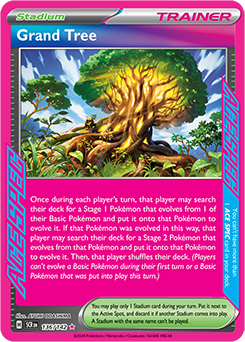Read on below to learn more about the new Stellar Crown expansion as part of Pokémon TCG: Scarlet & Violet.
Get an in-depth look at Grand Tree, Terapagos ex, Area Zero Underdepths, Briar, Sparkling Crystal, and Noctowl.
By Xander Pero, Contributing Writer
With the release of the latest Pokémon TCG expansion, Scarlet & Violet—Stellar Crown, comes the debut of many new and exciting cards. This set features the first card featuring Terapagos, the mascot of The Hidden Treasure of Area Zero Part 2: The Indigo Disk, and a roster of other Pokémon that support a strategy built around Tera Pokémon ex. Read on to learn about which six cards I crown as top picks that will make an impact on the Standard format!
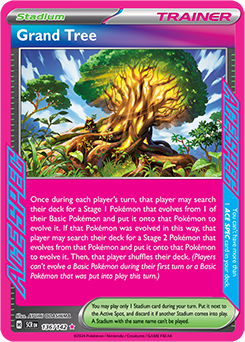
The powerful Grand Tree ACE SPEC Stadium gives a super lift to Evolution decks. With this Stadium in play, once per turn, you may fully evolve a Basic Pokémon into a Stage 1 (and subsequent Stage 2) Pokémon from the deck. The slight downside is that the Basic Pokémon must have been in play for at least one turn, following traditional Evolution rules. This card will provide additional evolving options to Stage 2 decks outside of the traditional Rare Candy. Moreover, if Grand Tree stays in play for more than one turn, you can continuously cultivate the benefits and establish multiple Evolution Pokémon.
The possibilities for Grand Tree are endless. While it doesn’t work very well with the popular Charizard ex—whose Infernal Reign Ability activates only when you play it from your hand—there are many other powerful Stage 2 Pokémon that it would pair well with, such as Pidgeot ex, Dragapult ex, and Dusknoir, among other niche choices. Most of these decks run Unfair Stamp or Prime Catcher as an all-around strong ACE SPEC card, but Grand Tree can offer additional consistency. It’s tough to say whether decks will change their ACE SPEC for these Pokémon, but it is a question to raise.
Though there isn’t an obvious use within the top meta decks now, Grand Tree is a powerful enough card that I expect it to be a prominent ACE SPEC of choice during its time in Standard format, which is why I chose to include it here. Plus, I find it uniquely interesting, so there’s perhaps a bit of bias too. I encourage you to find the right Pokémon to pair it with!
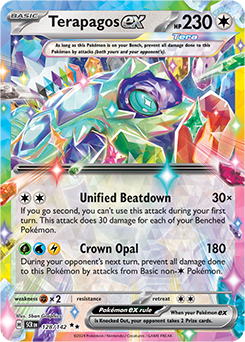
It’s now time to talk about everyone’s favorite turtle Pokémon: Terapagos ex, the star of the expansion. There have been many strategies over the years that do increased damage for the number of Benched Pokémon you have in play. To name a few, we have M Rayquaza-EX, Eternatus VMAX, and the still-Standard-legal Origin Forme Palkia VSTAR. M Rayquaza-EX had Emerald Break and Eternatus VMAX had the Eternal Zone Ability, which allowed them to increase their attack’s total damage output. Now we have Area Zero Underdepths, which also caps each player’s Bench at eight Pokémon. History tends to repeat itself!
Some notable supporting Pokémon that also release in this set are Fan Rotom, Bouffalant, and Noctowl. I’ll talk more about Noctowl later, but for now, just know that it enables the deck’s engine while filling out the Bench. Fan Rotom’s powerful Fan Call Ability lets you search out three Colorless-type Pokémon on your first turn. In some cases, you could grab two Hoothoot and one Noctowl, and in other cases, you may find yourself searching for two Bouffalant and a Hoothoot. The only stipulation is that these Pokémon must have 100 HP or less, so it’s convenient that both Bouffalant and Noctowl have exactly 100 HP!
Though these Colorless-type Pokémon directly benefit Terapagos ex, remember that Unified Beatdown does additional damage regardless of the type of your Benched Pokémon. You can use other supporting Pokémon, like Lumineon V, Dusknoir, and Fezandipiti ex. And if you so desire, you can also include the appropriate Basic Energy to fulfill Crown Opal’s attack cost—with the help of Noctowl’s Jewel Seeker Ability, powering up a Terapagos ex is as easy as searching for two copies Glass Trumpet.
There are also many decks you can build that include Terapagos ex to fulfill the Tera Pokémon requirements of Area Zero Underdepths, Noctowl, or Briar but focus on a separate attacker. I will continue to mention these as we go. For now, on to the next card!
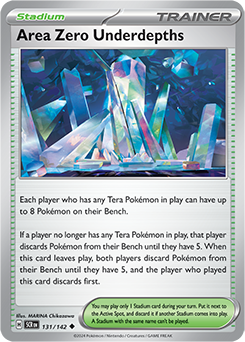
Next up, we have the Stadium that makes the magic happen: Area Zero Underdepths. Without this card, Terapagos ex would fall short of the right damage numbers to Knock Out most Basic Pokémon V or Pokémon ex. But that’s not the only story with Area Zero Underdepths. This card enables other strategies to shine, such as Palkia VSTAR and Regigigas. With this Stadium, Palkia VSTAR can increase its damage cap, and Regigigas can power up a non-Regi Pokémon using the additional Bench space. Despite the limitation of requiring a Tera Pokémon in play, Area Zero Underdepths facilitates a variety of strategies because you have seven Bench spaces at your fingertips.
But wait, there’s more! If you thought these strategies were the only ones that would play Area Zero Underdepths, you’d be sorely mistaken. In the same way that some comeback decks played Collapsed Stadium to remove two-Prize liabilities like Rotom V and Lumineon V, these same decks can play Area Zero Underdepths to overfill their board. Once the Stadium is removed or the Tera Pokémon are removed from play, the unwanted Bench-sitters are discarded. It’s unique that Area Zero Underdepths has the additional condition of requiring a Tera Pokémon in play. Though this can be viewed as a downside, with a card with like Professor Turo’s Scenario, you can beneficially reduce your own Bench size without replacing the Stadium.
Expect to see many decks use Area Zero Underdepths to its greatest potential over the next few years. I’m excited to see how people will incorporate Stellar Tera Pokémon ex with the toolbox of supporting cards released in Scarlet & Violet—Stellar Crown.
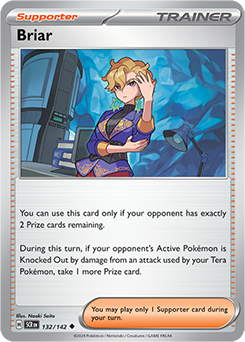
With the recent popularity of Regidrago VSTAR decks, the current Standard metagame has warped into a race for each opponent to take their Prize cards as quickly as possible, traditionally two at a time. To that end, taking the first singular Prize card is nice, but it may not matter if your opponent can continuously retaliate for two Prize cards turn after turn. Enter Briar, the card that can change just that. Under the right circumstances, Briar can allow you to take an additional Prize card upon Knocking Out an opposing Pokémon, swinging the game in your favor.
From an outside perspective, it appears that Briar was designed to combat this exact issue. Take a Charizard ex deck, for example, which doesn’t mind being behind one Prize card at the start of the game. Opposing decks are forced to take the first Prize card, since there is no rush for the Charizard ex player to put a Pokémon ex into play. From that point onward, if the Charizard ex player can take two Prize cards at a time, victory is guaranteed.
This above scenario isn’t completely foolproof for a few reasons. First, many Standard decks contain ways to take multiple Prize cards in one turn against single-Prize Pokémon. Dragapult ex can spread damage, Regidrago VSTAR can copy the attacks of Dragapult ex or Kyurem, and decks with Iron Hands ex can use Amp You Very Much. We’ve also seen some innovations with Dusknoir, which trades one-for-one in Prize cards but allows you to force the opponent into a situation where they have an odd number of Prize cards remaining (while you have an even number).
Nonetheless, Briar could allow decks without these inherent capabilities to combat this issue. It’s possible to build a deck focused on a non-Tera Pokémon (like Palkia VSTAR) that wants to make use of Area Zero Underdepths. Palkia VSTAR decks can then use Terapagos ex and Briar to take three Prize cards on Fezandipiti ex or Lumineon V, which are common in Charizard ex and Dragapult ex decks.
Though all of this may seem like it disadvantages Charizard ex and Dragapult ex—the two most popular Stage 2 Pokémon—remember that these two are also Tera Pokémon! These decks can take advantage of Briar, flipping the script on any of the strategies I have previously mentioned.
It will be interesting to see how the meta evolves to incorporate Briar, alongside other potential ways to make it stronger, such as Dusclops and Dusknoir. If the opponent has three Prize cards remaining, you can use the Cursed Blast Ability to bring the opponent to two Prize cards, activating Briar. In other games, if the opponent has two Prize cards remaining, you can play Briar, then use Cursed Blast to make it easier to take a Knock Out and an extra Prize card! Personally, I’m most excited to try out decks that can exploit this interaction.
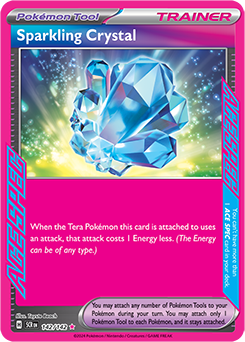
Continuing with the Tera trend, we now reach the extremely useful Pokémon Tool card Sparkling Crystal, which lets the Tera Pokémon it’s attached to use an attack for one less Energy—of any type. The most immediate application is with Dragapult ex. While attached, you can use Phantom Dive for either a single Fire or Psychic Energy. The greatest benefit over Neo Upper Energy, the current analogous ACE SPEC of choice, is that Sparkling Crystal can be found with Arven.
As more Stellar Tera Pokémon are released, Sparkling Crystal’s potential value will continue to increase. Because these Pokémon’s powerful attacks require multiple Energy types, they can be difficult to use. Sparkling Crystal can substitute for whichever type you are missing while reducing the total Energy required to attack. I look forward to trying out Sparkling Crystal with different Tera Pokémon, especially in a deck that may use multiple Tera Pokémon for specific matchups!
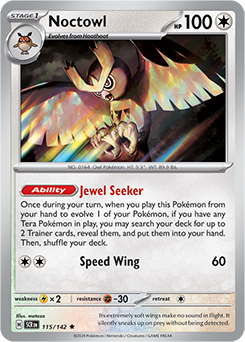
Finally, we have reached my favorite card from the new set. Fans may remember Drizzile and Inteleon from Sword & Shield. Their Shady Dealings Ability allowed the player to search their deck for one or two Trainer cards upon evolving. These cards began the shift towards “tutoring” engines, allowing the player to search their deck for a desired card rather than hoping to draw into it while using a traditional draw Supporter. Nowadays, these engines are as popular, if not more so, than their turn-and-burn counterparts. Miraidon ex, the most aggressive deck in Standard, picks Arven as its main Supporter card!
Let’s now talk about Noctowl, which gives you Inteleon’s Shady Dealings on a Stage 1 Pokémon. Though you need a Tera Pokémon in play to activate its Jewel Seeker Ability, that requirement is well worth the tradeoff. I’m certain that Noctowl will be used throughout its entire lifetime in the Standard format, sometimes as a thin 2–2 line and other times as a complete 4–4 line of Hoothoot and Noctowl.
Fan Rotom, also debuting in Scarlet & Violet—Stellar Crown, is Noctowl’s greatest ally. Its Fan Call Ability lets you search for up to three Colorless-type Pokémon with 100 HP or less during your first turn. With a single Buddy-Buddy Poffin, you can find Fan Rotom and another Basic Pokémon like Charmander—and then grab two Hoothoot and one Noctowl with Fan Call!
Comparing Noctowl to Pidgeot ex, you only need one card to activate it—assuming you have a Tera Pokémon in play, you only need Noctowl—and you get two cards immediately. On the other hand, Pidgeot ex requires two cards (Rare Candy and Pidgeot ex) and finds one card per turn. Though Noctowl is limited to finding Trainer cards, this isn’t much of a hindrance because many Trainer cards can find the Pokémon or Energy you wish for. The overall comparison I’m trying to make here is that Noctowl allows for more explosive swings, whereas Pidgeot ex is a static supporting Pokémon. Pidgeot ex is especially useful against an opposing Iono.
I expect many decks with Tera Pokémon to try a Noctowl engine, in the same way that Charizard ex and Dragapult ex decks have had iterations involving Bibarel or Pidgeot ex over past formats. Specific decks like Terapagos ex and Palkia VSTAR can greatly benefit from Noctowl as a supporting Pokémon, boosting consistency while increasing damage output.
Personally, I am eager to try a deck that uses Noctowl to pull off an absurd combo. Some current ideas that I have involve Origin Forme Dialga VSTAR, Dusknoir plus Briar combinations, or Kyurem. Though these combo ideas are still in the workshop, expect to see Noctowl make its way into already popular archetypes.
These are just a select few of the many cards releasing in the new Scarlet & Violet—Stellar Crown expansion. I encourage you to try out other cards I haven’t discussed, like Galvantula ex, Crispin, and Glass Trumpet. With over 140 new cards, 14 Pokémon ex, and three new ACE SPEC cards, there are many combinations to try. Will you crown yourself as champion?
For more Pokémon TCG strategy and analysis, visit Pokemon.com/Strategy.
Xander Pero

Xander Pero is a contributing writer for Pokemon.com. He was an avid fan until discovering sanctioned tournaments in 2009. He formerly traveled often for the Top 16 circuit, but now spends his time focusing on university, where he studies industrial engineering. You can find him at various tournaments, as well as on X at @xanderpero.
Source: Pokemon.com
Source: Pokemon

